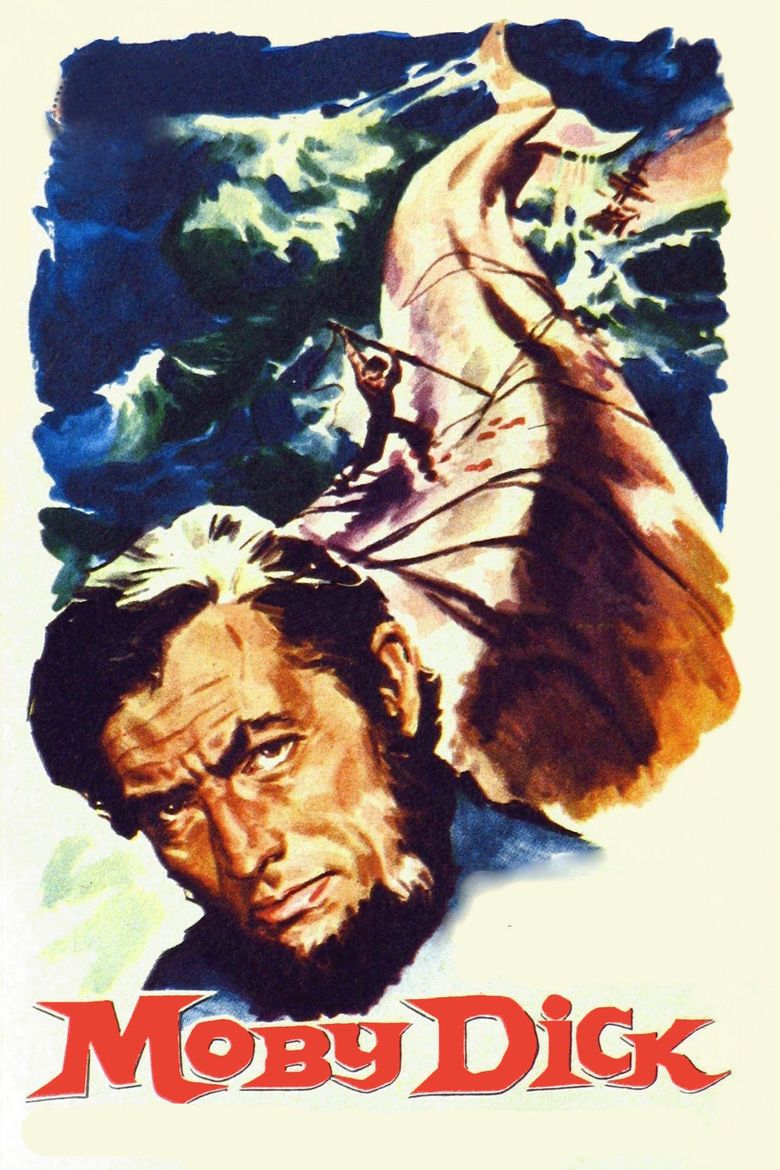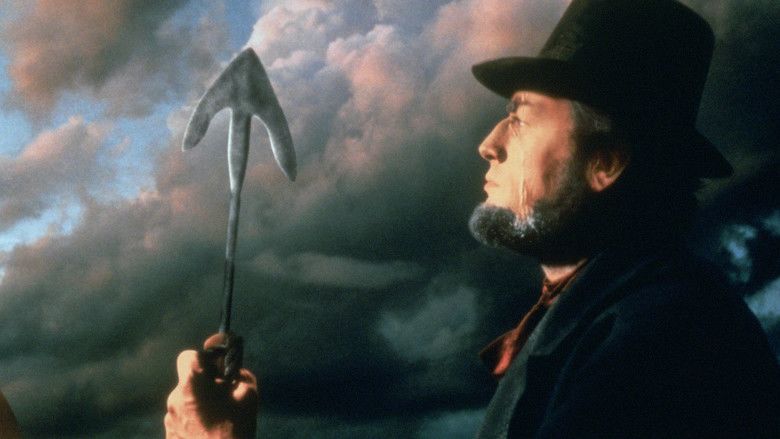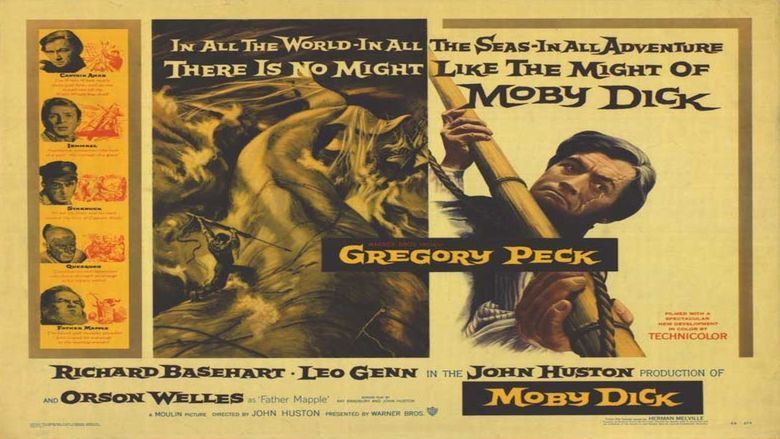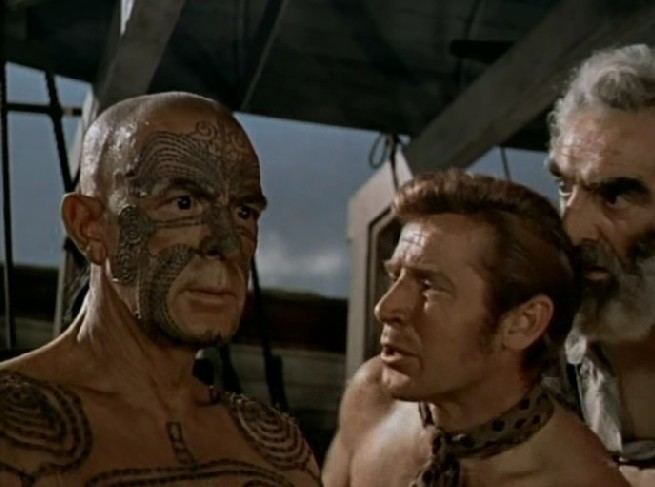Moby Dick (1956 film)
8 /10 1 Votes
84% Rotten Tomatoes Genre Adventure, Drama Duration Language English | 7.4/10 IMDb Country United States | |||||||||||||||||||||||||||||||||
 | ||||||||||||||||||||||||||||||||||
Release date June 27, 1956 (1956-06-27) Based on Moby-Dick byHerman Melville Cast (Captain Ahab), (Ishmael), (Starbuck), (Captain Boomer), (Stubbs), (The Manxman) Similar movies John Wick , Taken 3 , Blackhat , Run All Night , Things to Do in Denver When You're Dead , Mission: Impossible III Tagline From the immortal adventure classic...of whaling men, their ships, and the sea! | ||||||||||||||||||||||||||||||||||
Capt. Ahab (Gregory Peck) has a vendetta against Moby Dick, the great white whale responsible for taking his leg. He sets out on a treacherous sea voyage aboard The Pequod, along with a crew including Starbuck (Leo Genn), Father Mapple (Orson Welles) and Ishmael (Richard Basehart), to hunt down the elusive beast. With reckless abandon, Ahab leads the crew on his obsessive and suicidal quest, anxious for a final showdown with the legendary white whale.
Contents

Moby Dick is a 1956 film adaptation of Herman Melvilles novel Moby-Dick. It was directed by John Huston with a screenplay by Huston and Ray Bradbury. The film starred Gregory Peck, Richard Basehart, and Leo Genn.
The music score was written by Philip Sainton.

In 1841, young Ishmael signs up for service abroad the Pequod, a whaler sailing out of New Bedford. The ship is under the command of Captain Ahab, a strict disciplinarian who exhorts his men to find Moby Dick, the great white whale. Ahab lost his his leg to that creature and is desperate for revenge. As the crew soon learns, he will stop at nothing to gain satisfaction.
Plot

Set in 19th-century New England, the story follows the whaling ship Pequod and its crew. Leading them is Captain Ahab, who was almost killed in an encounter with the "great white whale", Moby Dick. Now he is out for revenge. With the crew that has joined him, Ahab is out to destroy the huge sea mammal, but his obsession with vengeance is so great that he cannot turn back, eventually leading to the death of Ahab and all of his crew, save his newest able seaman, Ishmael.
Cast
Peck was initially surprised to be cast as Ahab (part of the studios agreement to fund the film was that Huston use a "name" actor as Ahab). Peck later commented that he felt Huston himself should have played Ahab. Ironically, Huston had originally intended to cast his own father, the actor Walter Huston in the role, but his father had died by the time the film was made. Peck went on to play the role of Father Mapple in the 1998 television miniseries adaptation of Melvilles novel, with Patrick Stewart as Ahab.

Welles later used the salary from his cameo to fund his own stage production of Moby Dick, in which Rod Steiger played Captain Ahab.

The Pequod was portrayed by, appropriately, the Moby Dick. Built in England in 1887 as the Ryelands, the ship came into the hands of the film industry in the 50s, and was also used in Treasure Island. It was destroyed by fire in Morecambe, England in 1972.
The schooners used were Harvest King and James Postlethwaite, both from Arklow, Ireland.

According to Gregory Peck, between his performances in this film and the 1998 Moby Dick miniseries, he liked the miniseries better because it was more faithful to the novel.
Production
During a meeting to discuss the screenplay, Ray Bradbury informed John Huston that regarding Melvilles novel, he had "never been able to read the damned thing". According to the biography The Bradbury Chronicles, there was much tension and anger between the two men during the making of the film, allegedly due to Hustons bullying attitude and attempts to tell Bradbury how to do his job, despite Bradbury being an accomplished writer. Bradburys novel Green Shadows, White Whale includes a fictionalized version of his writing the screenplay with John Huston in Ireland. Bradburys short story "Banshee" is another fictionalized account of what it was like to work with Huston on this film. In the television adaptation of the story for The Ray Bradbury Theater the Huston character was played by Peter OToole and the Bradbury surrogate by Charles Martin Smith.
Huston had always wanted to make a film of Moby-Dick, and wanted to cast his father Walter as Ahab. Unfortunately, Walter had died in 1950, before the film was financed. The film was bankrolled by brothers Walter, Harold, and Marvin Mirisch, who financed Hustons Moulin Rouge. The Mirisches made a deal with Warner Bros. in order to release the film. Under the agreement, Warners would distribute Moby Dick for seven years, after which all rights would revert to the Mirisch brothers company, Moulin Productions.
The film began shooting in Wales at Hustons request. Parts of the movie were shot at the sea in front of Canical, a traditional whaling parish in Madeira Islands, Portugal, with real action of whaling, done by whalers of Madeira Island. It was also filmed in Las Canteras beach, Las Palmas de Gran Canaria, Canary Islands, Spain. Captain Alan Villiers commanded the ship for the film.
Many exterior scenes set in New Bedford were shot on location in Youghal, Co. Cork, Ireland. The town has a public house, originally called Linehans and at that time owned by Paddy Linehan, whose exterior appears in the movie. It was renamed Moby Dicks shortly after filming by Mr. Linehan. It is still owned and run by the Linehan family and boasts a fine collection of photographs taken of the cast and crew during the making of the film. While there, John Huston used the bar as his headquarters to plan each days filming. The towns harbor basin, in front of Moby Dicks bar, was used to stand in as New Bedfords harbor, and some local people appear as extras in the ships departure scene. Youghals nineteenth century lighthouse also appears in a scene of the Pequod putting to sea (at sunset) on her fateful voyage.
Of the three film versions of Moby Dick made between 1926 and 1956, Hustons is the only one which is faithful to the novel and uses its original ending.
A myth that was put to rest in cinematographer Oswald Morris autobiography, Huston, We Have A Problem, is that no full length whale models were ever built for the production. Previous accounts have claimed that as many as three 60-foot rubber "white whales" were lost at sea during filming making them "navigational hazards". In fact the titular whale shown in the film was constructed by Dunlop in Stoke-on-Trent, England. Moby Dick was 75 ft long and weighed 12 tons, and required 80 drums of compressed air and a hydraulic system in order to remain afloat and operational. However the artificial whale came loose from its tow-line and drifted away in a fog. Peck confirmed in 1995 that he was aboard the prop. According to Morris, after the prop was lost the Pequod was followed by a barge with various whale parts (hump, back, fin, tail). 90% of the shots of the white whale are various size miniatures filmed in a water tank in Shepperton Studios in London. Whales and longboat models were built by a special effects man, August Lohman, working in conjunction with art director Stephen Grimes. Studio shots also included a life-size Moby jaw and head - with working eyes. The head apparatus which could move like a rocking horse was employed when actors were in the water with the whale. Gregory Pecks last speech is delivered in the studio while riding the white whales hump (a hole was drilled in the side of the whale so Peck could conceal his real leg).
The films problems were further escalated by rising costs. The film went overbudget, from $2 million to around $4.4 million, which crippled Moulin Productions; Moby Dick was ultimately sold to United Artists in order to recoup some of the Mirisch brothers debt (Warners still distributed the film, corresponding to their original licensing agreement). Moby Dick did not recoup its budget upon its initial release.
Peck and Huston intended to shoot Herman Melvilles Typee in 1957, but the funding fell through. Not long after, the two had a falling out. According to one biography, Peck discovered to his disappointment that he had not been Hustons choice for Ahab, but in fact was thrust upon the director by the Mirisch brothers to secure financing. Peck felt Huston had deceived him into taking a part for which Peck felt he was ill-suited. Years later, the actor tried to patch up his differences with the director, but Huston, quoted in Lawrence Grobels biography The Hustons, rebuked Peck ("It was too late to start over," said Huston) and the two never spoke to each other again. Nevertheless, Hustons daughter Anjelica confirmed in a 2003 Larry King Live interview that her father had "adored" Peck.
In the documentary accompanying the DVD marking the 30th anniversary of the film, Jaws, director Steven Spielberg states his original intention had been to introduce the Ahab-like character Quint (Robert Shaw), by showing him watching the 1956 version of the film and laughing at the inaccuracies therein. However, permission to use footage of the original film was denied by Gregory Peck as he was uncomfortable with his performance.
At the age of four, Anjelica Huston met Peck dressed as Ahab when she visited the set of her fathers film. Decades later, she and Peck would meet again and become close friends with each other until the latters death.
Changes from the original novel
Although the film was quite faithful to the original novel, even down to the retention of Melvilles original poetic dialogue, there were several slight changes:
Similar Movies
Herman Melville wrote the story for Moby Dick and The Sea Beast. Age of the Dragons (2010). Down To the Sea in Ships (1949). Free Willy 3: The Rescue (1997). Gregory Peck and James Robertson Justice appear in Moby Dick and Captain Horatio Hornblower RN.
Reception
The film has an 84% rating on Rotten Tomatoes, with the consensus that "It may favor spectacle in place of the deeper themes in Herman Melvilles novel, but John Hustons Moby Dick still makes for a grand movie adventure."
References
Moby Dick (1956 film) WikipediaMoby Dick (1956 film) IMDbMoby Dick (1956 film) Rotten TomatoesMoby Dick (1956 film) themoviedb.org
